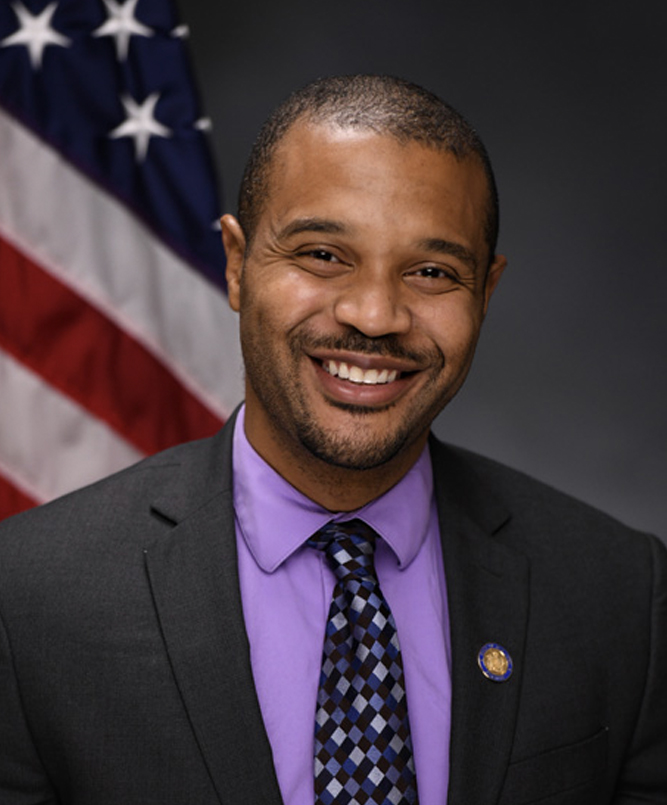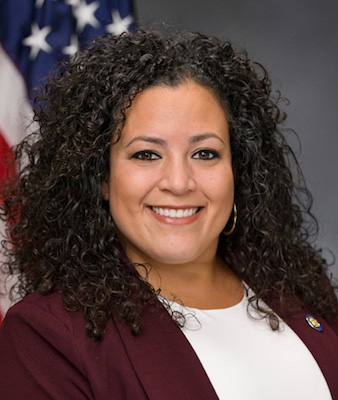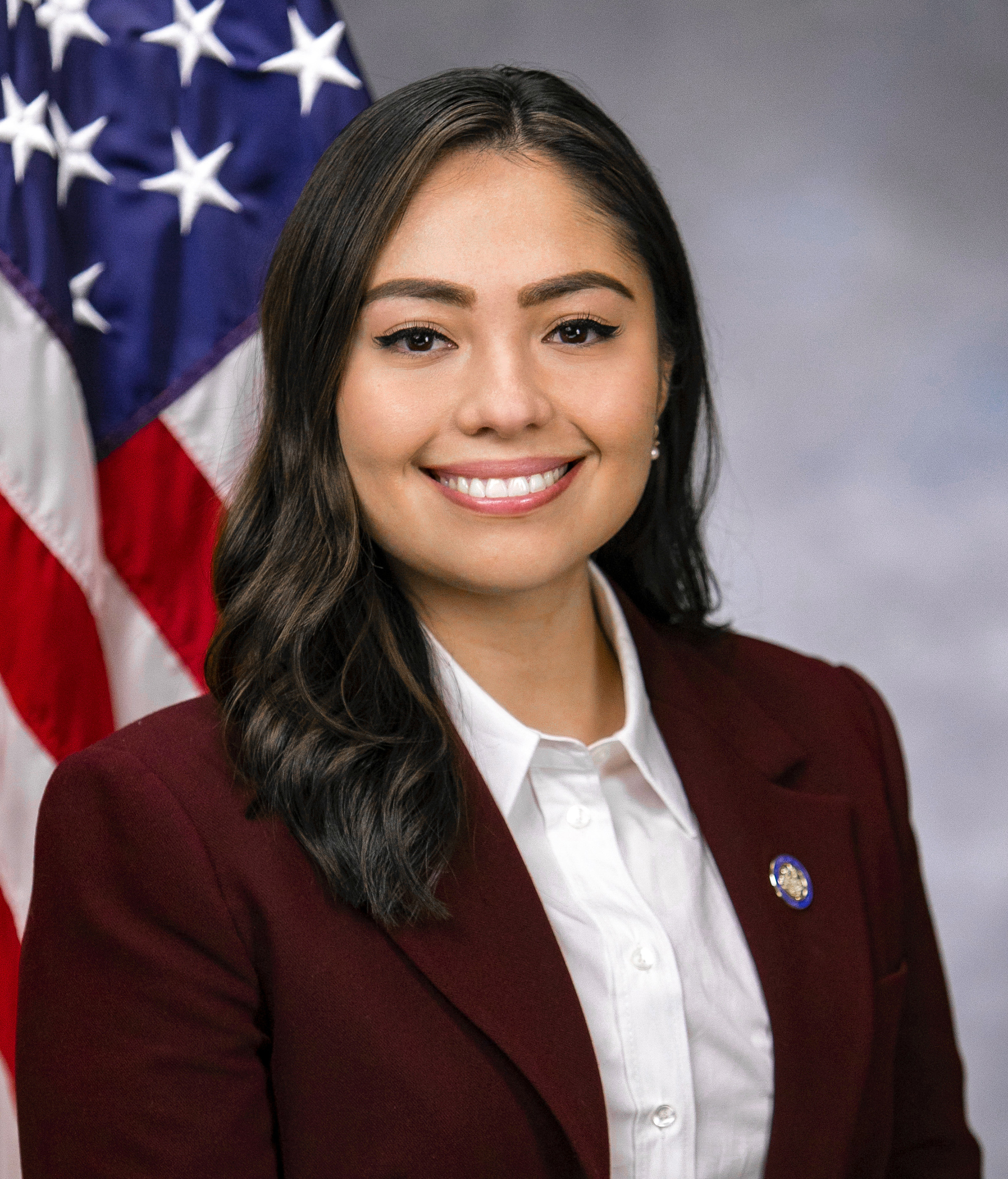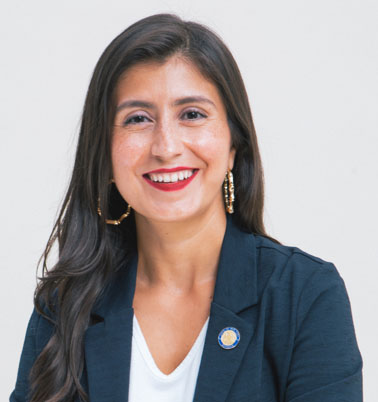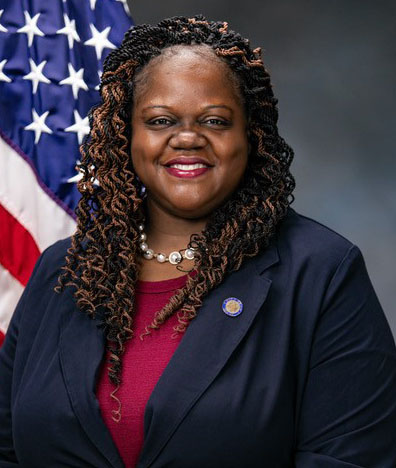|
Assembly Actions -
Lowercase Senate Actions - UPPERCASE |
|
|---|---|
| Jan 03, 2024 |
referred to crime victims, crime and correction |
| Nov 27, 2023 |
referred to rules |
Senate Bill S7772
2023-2024 Legislative Session
Protects the rights of people in prisons, jails and forensic facilities
download bill text pdfSponsored By
(D, WF) 18th Senate District
Archive: Last Bill Status - In Senate Committee Crime Victims, Crime And Correction Committee
- Introduced
-
- In Committee Assembly
- In Committee Senate
-
- On Floor Calendar Assembly
- On Floor Calendar Senate
-
- Passed Assembly
- Passed Senate
- Delivered to Governor
- Signed By Governor
Actions
co-Sponsors
(D, WF) 25th Senate District
(D) 30th Senate District
(D) 34th Senate District
(D, WF) 59th Senate District
(D, WF) 31st Senate District
(D, WF) 21st Senate District
(D, WF) 13th Senate District
(D) 32nd Senate District
(D, WF) 52nd Senate District
2023-S7772 (ACTIVE) - Details
- See Assembly Version of this Bill:
- A8364
- Current Committee:
- Senate Crime Victims, Crime And Correction
- Law Section:
- Correction Law
- Laws Affected:
- Amd §§2 & 137, Cor L
- Versions Introduced in 2025-2026 Legislative Session:
-
S3763, A1261
2023-S7772 (ACTIVE) - Sponsor Memo
BILL NUMBER: S7772
SPONSOR: SALAZAR
TITLE OF BILL:
An act to amend the correction law, in relation to the rights of people
in prisons, jails, and forensic facilities
PURPOSE OR GENERAL IDEA OF BILL:
This bill aims to accomplish two goals: (1) to clearly place the rights
of incarcerated people and their families in New York within the frame-
work and protections of international human rights law and norms, and
(2) to correct, clarify, and establish certain specific protections
relating to how incarcerated individuals and their families are treated
within New York's prisons, jails, and secure forensic facilities,
including relating to visitation, use of segregated confinement, due
process rights, packages, and other matters.
SUMMARY OF SPECIFIC PROVISIONS:
Section 1 states the name by which the bill shall be known, which is the
"Rights Behind Bars; Protecting the Rights of People in Prisons, Jails, and Forensic Facilities, and Their Loved Ones, in New York State Act.". Section 2 sets forth, in five parts, the legislative findings and intent: PART A recognizes the systematic lack of human rights protections for incarcerated individuals and their loved ones in New York, and the necessity for the legislature to clarify rights that exist under New York law but are not consistently followed, to close gaps in existing law, and to enshrine into New York law well-established principles and obligations under international human rights law. PART B cites a sampling of relevant studies, reports, and legal deci- sions which support the need for this legislation. PART C cites relevant provisions of the New York and U.S. consti- tutions, as well as key portions of international human rights law docu- ments relating to the rights of incarcerated people, including the United Nations Declaration of Human Rights, the International Covenant of Civil and Political Rights, the Basic Principles for the Treatment of Prisoners, the Convention Against Torture and Other Cruel, Inhuman, or Degrading Treatment or Punishment, and the United Nations Standing Mini- mum Rules for the Treatment of Prisoners (the Nelson Mandela Rules.) PART D focuses on particular sections of the Mandela Rules which provide guidance as to the treatment of people who are incarcerated, including, Rule 3 (prohibiting, generally, actions which "aggravate the suffering inherent" in cutting people off from the outside world and depriving them of their liberty), Rule 4 (requiring that incarceration be used to "ensure the reintegration OF INCARCERATED PERSONS into society upon release"), Rule 5 (requiring carceral facilities to "minimize any differences between prison life and life at liberty that tend to lesson . . . the respect due to their dignity as human beings"), Rule 58.1 requiring that people be allowed regular communication with family and friends, Rule 22 requiring the rights of people in prison to nutritious and wholesome food, and Rule 82 prohibiting any use of force against an incarcerated person that is not strictly necessary." PART E notes specific areas which have arisen in recent years in New York correctional facilities, including systemic violations of the HALT Solitary Confinement Law, improper and unjustified restrictionsPackages, visits, and mail, staff abuse and brutality, and other issues, and states the intent of the legislation, namely, to clarify and enforce the human rights of incarcerated individuals in New York. Section 3 amends correction law section 2 by the addition of eleven paragraphs which define the following terms: "contact visit", "visitor", "cell", "cell confinement", "out-of-cell", "congregate recreation", "core programs", "represented", "personal property", "secure facility", and "incarcerated individual." Section 4 amends correction law section 2 (23) through the addition of three paragraphs: (a) allows cell confinement beyond seventeen hours per day for medical or mental health treatment only with determination that such confinement is medically necessary, b) renders any such confinement null if not medically necessary and if the environment is not as least restrictive as appropriate, and (c) sets forth items and activities incarcerated to which persons in such medically necessary confinement must have access. Section 5 amends correction law section 2 (33) related to the phrase "special populations" to make clear via examples what is already required under settled law per the HALT Solitary Confinement Law that all people with mental health diagnosis, on the mental health caseload, with any intellectual, developmental, or cognitive impairment, with traumatic brain injury or organic brain syndrome, who have been on the mental health case-load or had a mental health diagnosis within the previous year, or who have had a diagnosis of intellectual, develop- mental, cognitive, physical, or sensorial disability with the previous year are protected. In addition, this section clarifies and extends the prohibition of imposing segregated confinement on individuals who are pregnant or in the post-partum recovery period or are caring for a child. Section 6 amends correction law section 137 (3) by requiring incarcerat- ed individuals be provided: weather appropriate clothing, sufficient quality of a variety of fresh food to meet Department of Health guide- lines, adequate mealtimes, and applicable wheelchair assistance. Section 7 amends correction law section 137 (5) by barring any use of force by staff against an incarcerated person except as a last resort after exhausting de-escalation techniques and where no alternatives exist to prevent imminent physical harm to another person, major proper- ty damage that raises an imminent safety or security risk, or escape. Even when authorized, staff shall only use the minimum amount of force required. This section also specifically bans the use of steel batons, prohibits retaliation, forbids staff from providing any false informa- tion in any official report, and makes all staff mandatory reporters of any observed misconduct by other staff. Section 8 amends correction law section 137 (6) law by the addition of seven paragraphs: (p) outlines visitation rights; including allowance for four in-person visitors every day for at least several hours per incarcerated individ- ual, access to showers prior to a visit, and related visitor rights. q) allows incarcerated individuals to receive packages in a timely manner, by mail or visitors, and eliminates any requirement that pack- ages be from or delivered by vendors. (r) emphasizes HALT's requirement of out-of-cell time and group program- ming by providing all incarcerated persons, apart from those in segre- gated confinement, access to at least fourteen hours of out-of-cell time per day, congregate programming and activities, and recreation. (s) requires that any correspondence incarcerated individuals receive must be delivered in its original form. (t) gives all incarcerated individuals access to anything technological- ly available, including use of personal tablets or devices, and free use of functions within that device to increase general connections and accessibility. This provision also requires that all personal phone calls and e-mails be free. (u) ensures commissaries are financially accessible and contain nutri- tious options. (v) permits incarcerated individuals to bring state court actions for any violations of this section. Section 9 amends correction law section 137 (6)(j)(ii) by adding two new clauses: (A) clarifying that time spent in certain locations does not constitute "out-of-cell" time, such as a "recreation area' contiguous to a cell, and (B) requiring that if a person voluntarily chooses not to participate in congregate out-of-cell time, they shall be offered access to comparable individual programming, recreation, and individual time away from their cells. Section 10 amends correction law 137 (6)(j)(v) by requiring that indi- viduals in residential rehabilitation units have access to the same programs available to the general population. Section 11 amends correction law section 137 (6)(j)(vii) prohibiting the use of restraints when individuals are participating in out-of-cell activities unless an individualized assessment is made at the time of or immediately following an incident that the use of restraints are required for the individual due to an imminent risk of serious physical injury to self or others. The assessment must be memorialized in writ- ing. A new subsection A requires the use of the least restrictive restraint possible for no more than the necessary amount of time. A new subsection B limits the use of restraints to the day applied unless a determination based on concrete evidence finds the contrary necessary. A new subsection C provides limits and regulations to continued use of restraints. Section 12 amends correction law section 137(6)(k) by the addition of three new subparagraphs: (v) sets specific limits to segregated confinement and residential reha- bilitation unit times, regardless of the number of charges associated with the incident at hand. (vi) requires that any imposition of a disciplinary sanction must be based on a finding of guilt of the charged act or acts by clear and convincing evidence. (vii) requires hearing officers to engage in a meaningful fact-finding process, with detailed statements of evidence and reasons why the incar- cerated individual's evidence or defense was credited or rejected. Section 13 amends correction law section 137 (6)(1) by the addition of five new subparagraphs: (i) provides for notice of the rights to representation for persons facing placement in segregated confinement or an RRU. (ii) requires people incarcerated and their representation, if applica- ble, to be provided all evidence relating to their charge and/or hearing as quickly as possible and no later than forty-eight hours prior to said hearing. (iii) lists the rights incarcerated people and their representatives, if applicable, have during hearings. (iv) requires a recording of all disciplinary hearings, and for such to be provided to the incarcerated person and their representative, if applicable. (v) allows for time spent in segregated confinement or a residential rehabilitation unit preceding a hearing to be credited as either the sanction imposed or as good time behavior allowance time, contingent on the outcome. Section 14 amends correction law section 137 (6)(o) by establishing the information that must be included in published monthly reports from the department. The amendment also outlines a detailed list of data and factors which must be included in said reports. Section 15 contains a severability clause. Section 16 provides that the provisions of this act shall take effect thirty days after becoming law. JUSTIFICATION: This "Rights Behind Bars" bill was developed by the sponsors in close collaboration with experts in the functioning of New York's jails and prisons, including legal experts, formerly incarcerated individuals, families of incarcerated or formerly incarcerated individuals, currently incarcerated individuals, and advocacy organizations focused on the rights of people behind bars in New York State. In addition, the Senate sponsor, who is the Chair of the Standing Committee on Crime Victims, Crime and Correction, has a significant amount of direct contact with incarcerated or formerly incarcerated people and their families and loved ones, based on numerous in-person visits to correctional facili- ties throughout the State and, further, based on the high level of tele- phone calls and letters the Senator's office receives from incarcerated or formerly incarcerated individuals or their families. All of this input led inescapably to two conclusions relating to the rights of people behind bars: (1) there are numerous important issues where the law of New York State is either not as clear as it could be or is not being implemented properly, to the detriment of people who are most directly impacted by incarceration, and (2) a more comprehensive vision, framework, and approach is needed in this State to ensure that the rights of people behind bars are protected. This bill, therefore, addresses, clarifies, and corrects numerous specific issues in New York - e.g., visitation rights, mail and package access, programming, excessive and unjustified uses of force by staff, misuse of segregated confinement, due process rights, food and meals, and more. In addition, in order to provide the appropriate overall framework for understanding and protecting the rights of people behind bars in New York, this bill also places these rights within a comprehen- sive framework established by international human rights law. This bill is both pragmatic in addressing a number of specific issues that frequently arise in New York's jails and prisons and is visionary in emphasizing the human rights of those behind bars and recognizing that New York is significantly out-of-compliance with accepted norms and rules of international human rights law as applicable to people held in custody. The enactment of this bill is essential. All New Yorkers have a right to expect that people held in custody are treated fairly, as human beings, and are not subjected to brutality, racism, denials of rights, interferences with visits or other forms of contact with the outside world, and are provided meaningful access to the programs and educational resources needed in order to return to their communities safely. In addition, New Yorkers should be, and are, shocked by the huge amounts of money the State is ordered to pay out in settlements and court verdicts in cases relating, among other things, to brutality from correctional staff. As this bill was being finalized for filing, for example, word came of a $9.25 million verdict against the New York pris- on system in a case of a man killed by the use by correctional staff of unnecessary and excessive force in one of the State's prisons. This court verdict is not unique, though it is large. The sponsors submit that if this bill were enacted, it would go a long way towards improving conditions within New York's jails and prisons, would result in significantly reduced violence, would make a huge difference in the preparation of individuals for successful re-entry to the community, and would improve family ties and relationships. All of this would have an impact on enhancing the human rights and human digni- ty of all. It would also result in significant cost savings for the State. RACIAL AND SOCIAL JUSTICE IMPACT: The long-standing racial disparities in New York's jails and prison systems are well-documented. The significant over-representation of people of color in New York's jails and prisons means, regardless of any other factors, that people of color are disproportionately subjected to violations of their basic human rights. When the actual and overt racism experienced by many people in jail and prison is also taken into account, it is clear that the continued failure of New York State to properly protect the safety, dignity, and human rights of incarcerated people is a major crisis with deep racial components. The enactment of this bill, with its corrections and clarifications of many specific issues as well as its placement of these issues within the larger frame- work of international human rights law, would have a significant impact on reducing the racism experienced by so many in the jails and prisons of this state. FISCAL IMPLICATIONS: To be determined. Implementation of these amendments will decrease instances of human rights violations, thereby significantly reducing litigation and judgments against the state. In addition, by reducing the trauma commonly experienced by people who are incarcerated, this bill will further save the state and localities money by significantly reduc- ing recidivism. EFFECTIVE DATE: This act shall take effect on the thirtieth day after it shall have become law.
2023-S7772 (ACTIVE) - Bill Text download pdf
S T A T E O F N E W Y O R K
________________________________________________________________________
7772
2023-2024 Regular Sessions
I N S E N A T E
November 27, 2023
___________
Introduced by Sens. SALAZAR, BRISPORT, CLEARE, GONZALEZ, JACKSON, RAMOS,
SEPULVEDA -- read twice and ordered printed, and when printed to be
committed to the Committee on Rules
AN ACT to amend the correction law, in relation to the rights of people
in prisons, jails, and forensic facilities
THE PEOPLE OF THE STATE OF NEW YORK, REPRESENTED IN SENATE AND ASSEM-
BLY, DO ENACT AS FOLLOWS:
Section 1. Short title. This act shall be known and may be cited as
the "rights behind bars; protecting the rights of people in prisons,
jails, and forensic facilities, and their loved ones, in New York state
act".
§ 2. Legislative findings and intent. The legislature hereby finds and
declares:
A. Incarcerated individuals, their families, and loved ones have human
rights. The legislature finds that New York's prisons and jails system-
atically fail to recognize and protect the human rights of incarcerated
individuals, their families, and their loved ones. While some of these
rights are protected by the law and constitution of New York State, and
the law and constitution of the United States, it is well-documented
that the rights protected under existing law are often not recognized in
practice and that there are gaps in existing law. The intent of this
act is to: (i) make clear some of the rights that already exist under
New York law but are not being consistently followed, (ii) close some of
the gaps in existing law, and (iii) enshrine into New York State law
some of the well-established principles and obligations under interna-
tional human rights law.
B. Numerous recent studies, reports, and court decisions have docu-
mented systemic, widespread, and persistent human rights violations in
New York's correctional facilities. These include: NYS Inspector General
Lucy Lang, RACIAL DISPARITIES IN THE ADMINISTRATION OF DISCIPLINE IN NEW
YORK STATE PRISONS, November 2022; Neff, Santo, and Meagher, HOW A 'BLUE
EXPLANATION--Matter in ITALICS (underscored) is new; matter in brackets
[ ] is old law to be omitted.
LBD13213-04-3
S. 7772 2
WALL' INSIDE NEW YORK STATE PRISONS PROTECTS ABUSIVE GUARDS, The Mars-
hall Project in partnership with the New York Times, May 2023; Neff,
Santo, and Meagher, IN NEW YORK PRISONS GUARDS WHO BRUTALIZE PRISONERS
RARELY GET FIRED, The Marshall Project in partnership with the New York
Times, May 2023; Law, V., THE WORST PRISON IN NEW YORK STATE, Prison
Legal News, March 2022; Gelardi and Brown, STATE PRISONS ARE ROUTINELY
VIOLATING NEW YORK'S LANDMARK SOLITARY CONFINEMENT LAW, New York Focus,
September 2022; Bryant, 19 PEOPLE HAVE DIED FROM NYC JAILS IN 2022, The
Vera Project, December 2022; Weill-Greenberg, DISABLED AND ABANDONED IN
NEW YORK STATE PRISONS, The Nation, October 2021; Marcius, HUNDREDS OF
WOMEN SET TO SUE NEW YORK OVER ALLEGATIONS OF PRISON SEX ABUSE, New York
Times, November 2022; Monitor's Reports in NUNEZ, ET AL. V. NYC DEPART-
MENT OF CORRECTION, ET AL., 11-cv-05845 (LTS) (SDNY) (multiple reports
issued by Court-appointed Monitor as part of the settlement of a class
action lawsuit relating to conditions in NYC jails on Rikers Island,
starting in 2016 and continuing to the present); and Post-Visit Briefing
Reports issued periodically by the Correctional Association of New York
("CANY") pursuant to their statutory authority to conduct monitoring
visits in NYS prisons (Nine Post-Visit Briefings were issued by CANY
from June 2021 through December 2022. Among the findings during this
period were that 45% of incarcerated individuals interviewed reported
witnessing or experiencing verbal, physical, or sexual abuse by prison
staff, and 36% reported witnessing or experiencing racialized abuse by
prison staff.).
C. Some of the human rights of incarcerated individuals in New York
State are protected by provisions in the New York State Constitution,
including, Article I, sections 5 (prohibiting cruel and unusual punish-
ment), 6 (right to due process), 8 (right to speak freely), 11 (guaran-
teeing equal protection of the laws), and 12 (prohibiting unreasonable
searches and seizures); the United States Constitution, including the
1st Amendment (free speech), 4th Amendment (prohibition of unreasonable
searches and seizures), 8th Amendment (prohibition of cruel and unusual
punishments), and 14th Amendment (guaranteeing equal protection of the
law and due process of law). However, these provisions and laws do not
go far enough to protect the rights of people incarcerated in New York.
The intent of this act, in part, is to incorporate into New York law
additional human rights protections for incarcerated people as enshrined
in key documents included in the body of international human rights law,
including, the United Nations Declaration of Human Rights, recognizing
basic human rights applicable to all people, including, in Article 5,
the right not to be subjected to torture or to cruel, inhuman, or
degrading treatment or punishment; the International Covenant of Civil
and Political Rights, including Article 7 (No one shall be subjected to
torture or to cruel, inhuman or degrading treatment or punishment), and
Article 10 (All persons deprived of their liberty shall be treated with
humanity and with respect for the inherent dignity of the human person);
the Basic Principles for the Treatment of Prisoners (General Assembly
Resolution 45/111); the Convention Against Torture and Other Cruel,
Inhuman, or Degrading Treatment or Punishment; the United Nations Stand-
ard Minimum Rules for the Treatment of Prisoners (the Nelson Mandela
Rules); and other applicable and binding principles of international
human rights law.
D. The fundamental approach of international human rights law to the
treatment of people in prison is expressed in Rule 3 of the Mandela
Rules, which recognizes that "imprisonment and other measures that
result in cutting off persons from the outside world are afflictive by
S. 7772 3
the very fact of taking from these persons the right of self-determina-
tion by depriving them of their liberty. Therefore the prison system
shall not, except as incidental to justifiable separation or the mainte-
nance of discipline, aggravate the suffering inherent in such a situ-
ation." In turn, Rule 4 requires that incarceration must be used to
"ensure the reintegration of such persons into society upon release so
that they can lead a law-abiding and self-supporting life" and Rule 5
thus requires prisons and jails to "minimize any differences between
prison life and life at liberty that tend to lessen the responsibility
of the {incarcerated people} or the respect due to their dignity as
human beings."
To effectuate these rights, the Mandela Rules require, among other
protections, that incarcerated people be allowed regular communication
with their family and friends, including through visits and through
writing, telecommunication, electronic means, and digital means (Rule
58.1), that people in prison have a right to "food of nutritional value
adequate for health and strength, of wholesome quality and well prepared
and served", and that any use of force against an incarcerated individ-
ual be "no more than is strictly necessary" (Rule 82). They also estab-
lish basic rights related to access to programming and treatment,
connections to community entities, and restrictions on the use of
restraints.
E. In keeping with these legislative findings, this act aims to clear-
ly recognize and establish the broad human rights framework that
protects all incarcerated individuals in New York State. This act
specifically addresses certain issues that have arisen in New York pris-
ons and jails in recent years. That has included: violations of the
HALT Solitary Confinement Law; restrictions on packages, visits, and
mail; staff abuse and brutality; and denials of other basic rights.
In regard to some of these issues, the law is already clear, but New
York's prisons and jails are not consistently following it. For example,
despite clarity concerning who qualifies as disabled under the HALT
Solitary Confinement Law, and who, therefore, cannot be placed in segre-
gated confinement, the NYS Department of Corrections and Community
Supervision has consistently placed people with disabilities in segre-
gated confinement. The intent of the amendments to paragraph (c) of
subdivision 33 of section 2 of the correction law made by section five
of this act is not to define disability, which is already in the law,
but rather to make clear via examples what is already required. Similar-
ly, while the correction law is already clear that people facing possi-
ble placement in segregated confinement or facing Tier III tickets must
have access to meaningful representation, including by any lawyer or law
student; that hearing officers must conduct individualized assessments
of the fact to determine if the allegations meet the threshold require-
ments for placement in segregated confinement or alternatives; and that
people in alternative disciplinary units must have access to out-of-cell
time in group settings, access to core programs available in the general
population; and a presumption against the use of restraints unless an
individualized determination is made finding a significant and unreason-
able risk, prisons and jails are not complying with these provisions and
so this act reiterates and clarifies these requirements.
This act is not intended as an all-inclusive compendium of the human
rights protections afforded to people in jail or prison under interna-
tional law, as the intent is to correct and clarify certain specific
rights within the overall human rights framework. Among other
protections, this act aims to ensure that people have a right to visit
S. 7772 4
with their loved ones, to have regular communication with their loved
ones, to receive care packages from their loved ones, to have access to
healthy and nutritious food, to be free from staff brutality and retali-
ation, to be free from the torture of prolonged solitary confinement,
and to have access to real and meaningful out-of-cell group programming
and engagement. Recognition of these basic human rights will alleviate
suffering of incarcerated individuals, strengthen ties with families and
communities, better prepare people for release, increase safety in pris-
ons and jails and in outside communities, and unequivocally establish as
the policy of the State of New York that brutality, racism, sexual
abuse, harassment, and denials of access to family and loved ones have
no place in New York's jails and prisons and will not be tolerated.
§ 3. Section 2 of the correction law is amended by adding eleven new
subdivisions 35, 36, 37, 38, 39, 40, 41, 42, 43, 44 and 45 to read as
follows:
35. "CONTACT VISIT" MEANS A VISIT BETWEEN AN INCARCERATED INDIVIDUAL
AND ONE OR MORE VISITORS IN A VISITING ROOM OR EQUIVALENT SPACE IN WHICH
THE INCARCERATED INDIVIDUAL AND THEIR VISITOR ARE IN THE SAME UNOB-
STRUCTED SPACE AS EACH OTHER WITHOUT PHYSICAL BARRIERS BETWEEN THE
INCARCERATED INDIVIDUAL AND THEIR VISITOR OR VISITORS, THAT IS CONDUCIVE
TO MEANINGFUL SOCIAL INTERACTION AND ACTIVITY, AND WITH THE ABILITY TO
INTERACT FREELY WITH THEIR VISITOR, INCLUDING BUT NOT LIMITED TO THE
ABILITY TO COMMUNICATE FREELY, HOLD HANDS, HUG, KISS, HAVE OTHER APPRO-
PRIATE PHYSICAL CONTACT, PURCHASE AND SHARE FOOD AND DRINKS FROM THE
VENDING MACHINE, AND TAKE PHOTOGRAPHS TOGETHER.
36. "VISITOR" MEANS ANY INDIVIDUAL WHO COMES TO VISIT A PERSON INCAR-
CERATED IN A CORRECTIONAL FACILITY OR SECURE FACILITY, INCLUDING, BUT
NOT LIMITED TO, A FAMILY MEMBER, FRIEND, ADVOCATE, OR LOVED ONE.
37. "CELL" MEANS ANY ROOM, AREA OR SPACE THAT IS USED OR IS INTENDED
TO BE USED BY AN INCARCERATED INDIVIDUAL FOR SLEEP, OR THAT IS NOT A
SHARED SPACE CONDUCIVE TO MEANINGFUL CONGREGATE SOCIAL INTERACTION AMONG
MANY PEOPLE IN A GROUP SETTING WHERE AN INDIVIDUAL IS HELD FOR ANY
PURPOSE.
38. "CELL CONFINEMENT" MEANS BEING IN A CELL.
39. "OUT-OF-CELL" MEANS BEING IN A SPACE OUTSIDE OF, AND IN AN AREA
AWAY FROM, A CELL, IN A GROUP SETTING WITH OTHER PEOPLE ALL IN THE SAME
SHARED SPACE WITHOUT PHYSICAL BARRIERS BETWEEN PEOPLE THAT IS CONDUCIVE
TO MEANINGFUL AND CONGREGATE SOCIAL INTERACTION AND ACTIVITY.
40. "CONGREGATE RECREATION" MEANS OUT-OF-CELL RECREATION IN A GROUP
SETTING WITH OTHER PEOPLE ALL IN THE SAME SHARED SPACE THAT TAKES PLACE
OUTSIDE, WEATHER PERMITTING, IN AN OPEN YARD WITHOUT BEING CAGED OR
COVERED, AND WHEN WEATHER DOES NOT PERMIT OR WHEN AN INCARCERATED INDI-
VIDUAL SO CHOOSES, IN A NON-CAGED GYMNASIUM OR EQUIVALENT.
41. "CORE PROGRAMS" MEANS ANY AND ALL PROGRAMS THAT CAN BE ASSIGNED BY
A DEPARTMENT PROGRAM COMMITTEE, ANY AND ALL REQUIRED DEPARTMENT
PROGRAMS, AND ANY AND ALL PROGRAMS THAT ARE CONSIDERED FOR PURPOSES OF
GOOD TIME, MERIT TIME, OTHER TIME ALLOWANCE, PAROLE RELEASE, OR OTHER
RELEASE MECHANISMS. CORE PROGRAMS SHALL INCLUDE, BUT NOT BE LIMITED TO,
ACADEMIC CLASSES, VOCATIONAL PROGRAMS, TRANSITIONAL SERVICES, ALCOHOL
AND SUBSTANCE ABUSE TREATMENT, AGGRESSION REPLACEMENT TRAINING, SEX
OFFENSE COUNSELING AND TREATMENT, AND ANY OTHER ASSIGNED OR REQUIRED
PROGRAMS.
42. "REPRESENTED" MEANS AN INCARCERATED INDIVIDUAL HAVING AN ATTORNEY
(LICENSED IN ANY JURISDICTION OF THE UNITED STATES), LAW STUDENT WITH
SUPERVISION BY ANY ATTORNEY REGARDLESS OF WHETHER THE ATTORNEY IS AFFIL-
IATED WITH A LAW SCHOOL, PARALEGAL, OR OTHER INCARCERATED INDIVIDUAL
S. 7772 5
PROVIDE REPRESENTATION AT ANY AND ALL STAGES OF A HEARING AND APPEAL,
INCLUDING BUT NOT LIMITED TO OPENING AND CLOSING STATEMENTS, PRESENTA-
TION OF EVIDENCE, CALLING AND QUESTIONING WITNESSES, CROSS-EXAMINING
WITNESSES, READING OF THE DISPOSITION, SENTENCING, AND APPEAL, WITH THE
CHOICE BY THE INCARCERATED INDIVIDUAL AND THEIR REPRESENTATIVE OF EITHER
HAVING THE REPRESENTATIVE PHYSICALLY PRESENT AT ANY AND ALL STAGES OF
THE HEARING IN THE SAME ROOM AND/OR PARTICIPATING THROUGH VIDEOCONFER-
ENCE.
43. "PERSONAL PROPERTY" MEANS ANY AND ALL PROPERTY THAT HAS BEEN
LAWFULLY IN THE POSSESSION OF AN INCARCERATED INDIVIDUAL, INCLUDING BUT
NOT LIMITED TO, FOR THE PURPOSES OF STATE CORRECTIONAL FACILITIES ALL
ITEMS LISTED IN DEPARTMENT DIRECTIVE FORTY-NINE HUNDRED THIRTEEN AS OF
JUNE FOURTEENTH, TWO THOUSAND TWENTY-TWO AND FOR PURPOSES OF LOCAL
CORRECTIONAL FACILITIES AND SECURE FACILITIES ALL ITEMS PERMITTED UNDER
APPLICABLE RULES AND REGULATIONS TO EACH FACILITY AS OF OCTOBER TWENTI-
ETH, TWO THOUSAND TWENTY-THREE. IF A PERSON HAS A STATIC TABLET,
PERSONAL PROPERTY INCLUDES A STATIC TABLET AND THE PERSON SHALL BE ABLE
TO USE THAT TABLET, IN ADDITION TO ANY OTHER TABLET, FOR PURPOSES OF
MAKING PHONE CALLS, EMAILS, AND OTHER USES. IF A PERSON IS AT A FACILITY
THAT ALLOWS TELEVISIONS, PERSONAL PROPERTY INCLUDES TELEVISIONS.
PERSONAL PROPERTY SHALL ALSO INCLUDE TYPEWRITERS, ASSISTIVE DEVICES,
APPROVED ELECTRONIC DEVICES, BOOKS-ON-TAPE PLAYERS, AND ANY OTHER PROP-
ERTY THAT AN INCARCERATED INDIVIDUAL HAS LAWFULLY HAD IN THEIR
POSSESSION.
44. "SECURE FACILITY" MEANS (A) ALL FORENSIC MENTAL HEALTH FACILITIES,
INCLUDING THOSE THAT HOLD PEOPLE PURSUANT TO SECTION 330.20 OR 730.50 OF
THE CRIMINAL PROCEDURE LAW OR 14 NYCRR PART 57, AND INCLUDING BUT NOT
LIMITED TO THE MID-HUDSON FORENSIC PSYCHIATRIC CENTER, KIRBY FORENSIC
PSYCHIATRIC CENTER, ROCHESTER REGIONAL FORENSIC UNIT, AND NORTHEAST
REGIONAL FORENSIC UNIT; (B) ALL SECURE TREATMENT FACILITIES, AS DEFINED
IN SUBDIVISION (O) OF SECTION 10.03 OF THE MENTAL HYGIENE LAW, INCLUDING
BUT NOT LIMITED TO THE CENTRAL NEW YORK PSYCHIATRIC CENTER AND ST.
LAWRENCE PSYCHIATRIC CENTER; AND (C) ALL SECURE MENTAL HEALTH FACILITIES
HOLDING PEOPLE PURSUANT TO SECTION FOUR HUNDRED TWO OR FIVE HUNDRED
EIGHT OF THIS CHAPTER.
45. "INCARCERATED INDIVIDUAL" MEANS ANY PERSON CONFINED IN A STATE OR
LOCAL CORRECTIONAL FACILITY OR SECURE FACILITY.
§ 4. Subdivision 23 of section 2 of the correction law is amended by
adding three new paragraphs (a), (b) and (c) to read as follows:
(A) A PERSON MAY ONLY BE PLACED IN CELL CONFINEMENT BEYOND SEVENTEEN
HOURS A DAY FOR PURPOSES OF MEDICAL OR MENTAL HEALTH TREATMENT IF A
LICENSED MEDICAL PROFESSIONAL DETERMINES THAT THE CELL CONFINEMENT
ITSELF IS MEDICALLY NECESSARY TO CARRY OUT THE MEDICAL OR MENTAL HEALTH
TREATMENT, SUCH AS FOR PURPOSES OF SUICIDE WATCH, MEDICAL ISOLATION, OR
MEDICAL QUARANTINE. SUCH DETERMINATION SHALL BE DOCUMENTED IN WRITING
AND SHALL BE REVIEWED AND REAUTHORIZED BY A LICENSED MEDICAL PROFES-
SIONAL AT LEAST ONCE EVERY FORTY-EIGHT HOURS.
(B) A PERSON MAY ONLY BE HELD IN SUCH CONFINEMENT PURSUANT TO PARA-
GRAPH (A) OF THIS SUBDIVISION FOR AS LIMITED A TIME AS MEDICALLY NECES-
SARY, AS EXCLUSIVELY DETERMINED BY MEDICAL OR MENTAL HEALTH STAFF, AND
IN THE LEAST RESTRICTIVE ENVIRONMENT THAT IS MEDICALLY APPROPRIATE, AS
DETERMINED EXCLUSIVELY BY MEDICAL OR MENTAL HEALTH STAFF.
(C) CELL CONFINEMENT PURSUANT TO PARAGRAPH (A) OF THIS SUBDIVISION
SHALL BE IN AN APPROPRIATE SPACE CONDUCIVE TO MEDICAL OR MENTAL HEALTH
TREATMENT. WHILE IN SUCH CONFINEMENT A PERSON SHALL AT LEAST HAVE ACCESS
TO: (I) A TABLET PURSUANT TO PARAGRAPH (T) OF SUBDIVISION SIX OF SECTION
S. 7772 6
ONE HUNDRED THIRTY-SEVEN OF THIS CHAPTER UNLESS A LICENSED MEDICAL
PROFESSIONAL DETERMINES THAT ACCESS TO A TABLET WOULD BE HARMFUL TO THE
PERSON BASED ON MEDICAL OR MENTAL HEALTH-RELATED REASONS; (II) HIS OR
HER FULL COMPLEMENT OF PROPERTY UNLESS A LICENSED MEDICAL PROFESSIONAL
DETERMINES THAT ACCESS TO A PARTICULAR ITEM IS INAPPROPRIATE FOR MEDICAL
OR MENTAL HEALTH-RELATED REASONS; AND (III) CORE PROGRAMS AND OTHER
PROGRAMMING AND ENGAGEMENT AVAILABLE TO PEOPLE INCARCERATED IN THE
GENERAL POPULATION BUT DONE IN A MANNER CONSISTENT WITH THE MEDICAL AND
MENTAL HEALTH TREATMENT BEING RECEIVED, SUCH AS AT A PHYSICAL DISTANCE
DETERMINED APPROPRIATE BY MEDICAL OR MENTAL HEALTH STAFF.
§ 5. Subdivision 33 of section 2 of the correction law, as added by
chapter 93 of the laws of 2021, is amended to read as follows:
33. "Special populations" means any person: (a) twenty-one years of
age or younger; (b) fifty-five years of age or older; (c) with a disa-
bility as defined in paragraph (a) of subdivision twenty-one of section
two hundred ninety-two of the executive law, INCLUDING BUT NOT LIMITED
TO: (I) ALL PEOPLE WITH ANY MENTAL HEALTH DIAGNOSIS; (II) ALL PEOPLE ON
THE OFFICE OF MENTAL HEALTH CASELOAD CURRENTLY; (III) ALL PEOPLE WITH
ANY INTELLECTUAL, DEVELOPMENTAL, OR COGNITIVE DIAGNOSIS; (IV) ALL PEOPLE
WITH ANY PHYSICAL DISABILITY DIAGNOSIS OR MOBILITY IMPAIRMENT; (V) ALL
PEOPLE WITH ANY SENSORIAL DISABILITY DIAGNOSIS; AND (VI) ALL PEOPLE WITH
TRAUMATIC BRAIN INJURY OR ORGANIC BRAIN SYNDROME; (D) WHO HAD BEEN ON
THE OFFICE OF MENTAL HEALTH CASELOAD, OR HAD ANY MENTAL HEALTH DIAGNO-
SIS, WITHIN THE PREVIOUS YEAR; (E) WHO HAD A DIAGNOSIS OF INTELLECTUAL,
DEVELOPMENTAL, COGNITIVE, PHYSICAL, OR SENSORIAL DISABILITY WITHIN THE
PREVIOUS YEAR; or [(d)] (F) who is pregnant, in the first [eight] TWELVE
weeks of the post-partum recovery period after giving birth, EXPERIENC-
ING A MISCARRIAGE, OR TERMINATING A PREGNANCY, OR LONGER IF MEDICALLY
NECESSARY, or caring for a child in a correctional institution pursuant
to [subdivisions] SUBDIVISION two or three of section six hundred eleven
of this chapter.
§ 6. Subdivision 3 of section 137 of the correction law, as amended by
chapter 322 of the laws of 2021, is amended to read as follows:
3. Each incarcerated individual shall be entitled to clothing suited
to the season and weather conditions, INCLUDING BUT NOT LIMITED TO
APPROPRIATE WINTER WEATHER CLOTHING, MULTIPLE LAYERS OF CLOTHING, AND
THE ABILITY TO WEAR PERSONAL CLOTHING UNDER STATE ISSUED CLOTHING WHEN
GOING TO PROGRAMS, RECREATION, VISITS, FACILITY MEDICAL, OR MEDICAL
TRIPS WHEN THE TEMPERATURE IS FORTY-FIVE DEGREES OR BELOW, and to a
sufficient quantity of QUALITY, wholesome and nutritious food, INCLUDING
A FULL RANGE AND VARIETY OF FRESH FRUITS AND VEGETABLES, CONSISTENT WITH
NUTRITIONAL GUIDELINE REQUIREMENTS DEVELOPED BY THE DEPARTMENT OF
HEALTH. MEDICALLY NECESSARY DIETS, INCLUDING BUT NOT LIMITED TO DIABETIC
AND HEART HEALTH DIETS, AND RELIGIOUS DIETS, SHALL BE PROVIDED AND BE OF
COMPARABLE QUALITY AND VARIETY AS GENERAL POPULATION MEALS.
(A) EACH INCARCERATED INDIVIDUAL SHALL BE AFFORDED SUFFICIENT TIME TO
EAT THEIR MEALS, INCLUDING THAT ALL PEOPLE SHALL BE PROVIDED AT LEAST
TWENTY MINUTES AFTER RECEIVING THEIR FOOD TO EAT DURING MEAL TIMES AND
THAT ANY PERSON WHO REQUIRES ADDITIONAL TIME DUE TO AGE OR DISABILITY
SHALL BE PROVIDED SUFFICIENT ADDITIONAL TIME. EACH INCARCERATED INDIVID-
UAL SHALL BE ALLOWED TO BRING LEFTOVER FOOD OUT OF THE MESS HALL IN A
SMALL BOWL. To the extent practicable, the clothing and bedding of
incarcerated individuals shall be manufactured and laundered in insti-
tutions in the department.
S. 7772 7
(B) EACH INCARCERATED INDIVIDUAL WHO USES A WHEELCHAIR SHALL BE
PROVIDED AN ASSISTANT TO HELP PUSH THE WHEELCHAIR IF THE PERSON WHO USES
THE WHEELCHAIR CHOOSES TO HAVE SUCH AN ASSISTANT.
§ 7. Subdivision 5 of section 137 of the correction law, as amended by
chapter 322 of the laws of 2021, is amended to read as follows:
5. No incarcerated individual in the care or custody of the department
shall be subjected to degrading treatment[, and no]. NO officer [or],
other employee of the department, OR OTHER GOVERNMENT EMPLOYEE shall
[inflict any blows whatever] USE FORCE upon any incarcerated individual,
[unless in self defense, or to suppress a revolt or insurrection. When
any incarcerated individual, or group of incarcerated individuals, shall
offer violence to any person, or do or attempt to do any injury to prop-
erty, or attempt to escape, or resist or disobey any lawful direction,
the officers and employees shall use all suitable means to defend them-
selves, to maintain order, to enforce observation of discipline, to
secure the persons of the offenders and to prevent any such attempt or
escape] EXCEPT AS A LAST RESORT AFTER EXHAUSTING DE-ESCALATION TECH-
NIQUES AND WHERE THERE ARE NO PRACTICAL ALTERNATIVES AVAILABLE TO
PREVENT: (I) IMMINENT PHYSICAL HARM TO OTHER INCARCERATED INDIVIDUALS,
STAFF, VISITORS, OR OTHER PERSONS; (II) MAJOR PROPERTY DAMAGE THAT RAIS-
ES AN IMMINENT SAFETY AND SECURITY RISK; OR (III) ESCAPE. WHEN THE USE
OF FORCE IS AUTHORIZED, OFFICERS AND EMPLOYEES SHALL ALWAYS USE THE
MINIMUM AMOUNT NECESSARY TO DEFEND THEMSELVES, TO SECURE THE PERSONS OF
INCARCERATED INDIVIDUALS, TO PREVENT IMMINENT PHYSICAL HARM, TO PREVENT
MAJOR PROPERTY DAMAGE THAT RAISES AN IMMINENT SAFETY AND SECURITY RISK,
AND TO PREVENT AN ESCAPE. ANY FORCE USED SHALL BE PROPORTIONAL TO THE
THREAT ENCOUNTERED. CONTRACTORS AND VOLUNTEERS ARE PROHIBITED FROM EVER
USING FORCE.
(A) ALL OFFICERS, DEPARTMENT EMPLOYEES, AND GOVERNMENT EMPLOYEES WORK-
ING OR OPERATING IN A CORRECTIONAL FACILITY SHALL BE PROHIBITED FROM
USING EXCESSIVE AND UNNECESSARY FORCE, FORCE AFTER CONTROL OF AN INCAR-
CERATED INDIVIDUAL HAS BEEN ESTABLISHED, AND ALL HIGH IMPACT FORCE,
INCLUDING BUT NOT LIMITED TO (I) STRIKES OR BLOWS TO THE HEAD, FACE,
GROIN, NECK, KIDNEYS, AND SPINAL COLUMN, (II) KICKS, AND (III) CHOKE
HOLDS, CAROTID RESTRAINT HOLDS, AND OTHER NECK RESTRAINTS EXCEPT WHERE A
PERSON IS IN IMMINENT DANGER OF DEATH OR EQUIVALENT LEVEL OF SERIOUS
BODILY INJURY AND WHERE LESSER MEANS ARE IMPRACTICAL OR INEFFECTIVE.
(B) NO OFFICER, OTHER EMPLOYEE OF THE DEPARTMENT, OR OTHER GOVERNMENT
EMPLOYEE WORKING OR OPERATING IN A CORRECTIONAL FACILITY SHALL CARRY OR
USE A STEEL BATON. ANY USE OF OTHER BATONS, CHEMICAL SPRAY, OR ANY OTHER
WEAPONS SHALL COMPLY WITH ALL PROVISIONS OF THIS SUBDIVISION.
(C) NO OFFICER, OTHER EMPLOYEE OF THE DEPARTMENT OR THE OFFICE OF
MENTAL HEALTH, OR OTHER GOVERNMENT EMPLOYEE WORKING OR OPERATING IN A
CORRECTIONAL FACILITY OR SECURE FACILITY SHALL CARRY OUT, NOR CAUSE
OTHERS TO CARRY OUT, ANY FORM OF RETALIATION AGAINST ANY PERSON INCAR-
CERATED IN A CORRECTIONAL FACILITY OR CONFINED IN A SECURE FACILITY FOR
REPORTING MISCONDUCT, REPORTING AN INCIDENT, RAISING A COMPLAINT, FILING
A GRIEVANCE, FILING A LAWSUIT, TAKING OTHER LEGAL ACTION, COMMUNICATING
WITH THE MEDIA, LAWMAKERS, THE CORRECTIONAL ASSOCIATION OF NEW YORK, AN
ATTORNEY, AN ADVOCATE, ANY INVESTIGATIVE BODY OR ANY OTHER PERSON OR
ENTITY, OTHERWISE EXERCISING OR ASSERTING THE RIGHTS OF INCARCERATED OR
CONFINED INDIVIDUALS OR ASSERTING RESPONSIBILITIES OF STAFF OR THE
DEPARTMENT, TAKING ANY OTHER SIMILAR ACTION, OR SUPPORTING ANOTHER
INCARCERATED OR CONFINED INDIVIDUAL IN TAKING ANY OF THE ACTIONS IN THIS
PARAGRAPH.
S. 7772 8
(D) NO OFFICER, OTHER EMPLOYEE OF THE DEPARTMENT OR THE DEPARTMENT OF
MENTAL HEALTH, OR OTHER GOVERNMENT EMPLOYEE WORKING OR OPERATING IN A
CORRECTIONAL FACILITY OR SECURE FACILITY SHALL PROVIDE ANY FALSE INFOR-
MATION ON A MISBEHAVIOR REPORT, UNUSUAL INCIDENT REPORT, USE OF FORCE
REPORT, OR ANY OTHER DOCUMENT, AND ALL OFFICERS, EMPLOYEES, AND GOVERN-
MENT EMPLOYEES WORKING OR OPERATING IN A CORRECTIONAL FACILITY OR SECURE
FACILITY SHALL HAVE A DUTY TO REPORT, AND PROVIDE ALL RELEVANT INFORMA-
TION REGARDING, ANY AND ALL OBSERVED MISCONDUCT BY ANOTHER OFFICER,
EMPLOYEE, OR PERSON WORKING OR OPERATING IN A CORRECTIONAL FACILITY OR
SECURE FACILITY.
§ 8. Subdivision 6 of section 137 of the correction law is amended by
adding seven new paragraphs (p), (q), (r), (s), (t), (u) and (v) to read
as follows:
(P) (I) ALL PERSONS INCARCERATED IN A CORRECTIONAL FACILITY OR SECURE
FACILITY SHALL HAVE THE RIGHT TO IN-PERSON CONTACT VISITS WITH UP TO
FOUR VISITORS AT A TIME, EVERY DAY OF THE WEEK FOR MANY HOURS PER DAY.
VISITATION SHALL BE ALLOWED AT ALL CORRECTIONAL FACILITIES AND SECURE
FACILITIES, SEVEN DAYS A WEEK, EVERY DAY OF THE YEAR. THE NUMBER,
LENGTH, AND FREQUENCY OF VISITS BY EACH VISITOR MAY BE LIMITED ONLY AS
NECESSARY TO ACCOMMODATE ALL VISITORS WHO ARRIVE DURING SCHEDULED VISIT-
ING TIMES, AND ANY SUCH LIMITATIONS SHALL NEVER INFRINGE UPON THE MINI-
MUM VISIT REQUIREMENTS IN THIS PARAGRAPH. MULTIPLE SETS OF VISITORS
SHALL BE ALLOWED TO VISIT AN INCARCERATED INDIVIDUAL AT DIFFERENT TIMES
ON THE SAME DAY, AND A VISITOR SHALL BE ALLOWED TO VISIT MULTIPLE INCAR-
CERATED INDIVIDUALS AT DIFFERENT TIMES ON THE SAME DAY. IF A VISITOR
LEAVES THE CORRECTIONAL FACILITY, THEY SHALL HAVE THE ABILITY TO RETURN
TO THE FACILITY THAT DAY TO PARTICIPATE IN A VISIT, INCLUDING EITHER
WITH THE SAME INCARCERATED INDIVIDUAL ORIGINALLY VISITED OR A DIFFERENT
INCARCERATED INDIVIDUAL.
(II) NEITHER THE DEPARTMENT NOR THE OFFICE OF MENTAL HEALTH MAY
RESTRICT AN INCARCERATED INDIVIDUAL'S VISITS AS A DISCIPLINARY MEASURE
OR FOR ANY OTHER REASON, NOR MAY EITHER AGENCY DENY OR RESTRICT A VISI-
TOR'S ABILITY TO VISIT SO LONG AS THE PERSON VISITED AGREES TO THE
VISIT.
(III) EACH CORRECTIONAL FACILITY AND SECURE FACILITY SHALL PROCESS
VISITORS AND BRING DOWN PEOPLE IN SUCH FACILITIES TO A VISIT AS EXPE-
DITIOUSLY AS POSSIBLE, INCLUDING ENSURING THAT THE VISITED PERSON AND
THEIR VISITOR ARE ABLE TO BE TOGETHER STARTING WITHIN ONE HOUR OF THE
VISITOR ARRIVING AT THE FACILITY, UNLESS THE VISITED PERSON VOLUNTARILY
CHOOSES TO TAKE MORE TIME TO COME FOR THE VISIT. ALL VISITORS WAITING
FOR A VISIT SHALL HAVE BASIC NEEDS MET WHILE WAITING, INCLUDING BUT NOT
LIMITED TO BEING ABLE TO WAIT INSIDE, BEING ABLE TO COMFORTABLY SIT, AND
HAVING ACCESS TO DRINKING WATER AND BATHROOM FACILITIES.
(IV) NO DRUG DETECTING DOGS MAY BE USED INSIDE OF ANY VISITING ROOMS
OR OTHER AREAS WHERE A VISITED PERSON IS MEETING WITH THEIR VISITOR.
(V) VIDEOCONFERENCING MAY SUPPLEMENT, BUT SHALL NOT TAKE THE PLACE OF,
IN-PERSON VISITS.
(VI) EACH INCARCERATED INDIVIDUAL SHALL BE PROVIDED THE OPPORTUNITY TO
TAKE A SHOWER BEFORE ANY VISIT.
(Q) ALL PERSONS IN A CORRECTIONAL FACILITY OR A SECURE FACILITY SHALL
HAVE THE RIGHT TO RECEIVE PACKAGES FROM ANY PERSON THROUGH DIRECT MAIL,
DURING A VISIT TO A CORRECTIONAL FACILITY OR SECURE FACILITY, OR BY MAIL
FROM COMMERCIAL SOURCES. THE DEPARTMENT SHALL NOT REQUIRE THAT PACKAGES
BE PURCHASED FROM OR DELIVERED BY A VENDOR, SHALL NOT REQUIRE THAT PACK-
AGES THAT ARE PURCHASED OR DELIVERED FROM A VENDOR COME FROM A PARTIC-
ULAR VENDOR OR VENDORS, AND SHALL NOT RESTRICT THE ABILITY OF A PERSON
S. 7772 9
TO DIRECTLY SEND ITEMS TO AN INCARCERATED INDIVIDUAL THROUGH THE FACILI-
TY PACKAGE ROOM OR DIRECTLY DELIVER ITEMS TO AN INCARCERATED INDIVIDUAL
THROUGH THE VISITING PROCESS. THE DEPARTMENT SHALL PROVIDE FOR PROMPT
DELIVERY TO INCARCERATED INDIVIDUALS OF ALL PACKAGES, INCLUDING PROMPT
DELIVERY OF PERISHABLE FOOD ITEMS TO AVOID EXPIRATION OR SPOILAGE. ALL
PACKAGES SHALL BE DELIVERED TO INCARCERATED INDIVIDUALS WITHIN FORTY-
EIGHT HOURS FROM THE TIME THE PACKAGE ARRIVES AT THE FACILITY, EXCEPT
THAT ALL PACKAGES THAT ARE BROUGHT ON A VISIT SHALL BE DELIVERED TO THE
INCARCERATED INDIVIDUAL ON THE SAME DAY AS THE VISIT. IF ANY ITEM IN A
PACKAGE IS DISALLOWED, THE INCARCERATED INDIVIDUAL SHALL HAVE THE OPTION
TO, WITHIN FOURTEEN DAYS OF RECEIVING WRITTEN NOTICE THAT THE ITEM IS
DISALLOWED, DONATE THE ITEM TO THE CHARITABLE ORGANIZATION OF THEIR
CHOOSING, RETURN THE ITEM VIA THE VISITING ROOM, OR RETURN THE ITEM VIA
MAIL AT THEIR OWN EXPENSE. ITEMS THAT MAY BE PART OF PACKAGES SHALL
INCLUDE, BUT NOT BE LIMITED TO THE FOLLOWING ITEMS, AND ANY RESTRICTIONS
ON THE PARTICULAR PACKAGING OF ANY SUCH ITEMS MUST BE REASONABLY AND
DIRECTLY RELATED TO A SIGNIFICANT SAFETY OR SECURITY CONCERN:
(I) FOOD UTENSILS AND FOOD ITEMS, WITHOUT ANY LIMIT ON THE NUMBER OF
POUNDS OR ITEMS, INCLUDING BUT NOT LIMITED TO FRESH FRUITS AND VEGETA-
BLES, COFFEE AND BEVERAGES, DRIED COFFEE CREAM, BREAD, POUCHED FOOD,
CANNED FOOD, CANDY, CHEESE, CONDIMENTS, MEATS, NUTS, OATMEAL AND CEREAL,
PASTRIES, RAISINS AND DRIED FRUIT, COOKED OR CURED OR SMOKED SEAFOOD,
AND SNACKS;
(II) PERSONAL COSMETICS AND PERSONAL HYGIENE PRODUCTS, INCLUDING BUT
NOT LIMITED TO SOAP, SHAMPOO, DEODORANT, AND FEMININE HYGIENE ITEMS;
(III) SEASONALLY APPROPRIATE INDOOR AND OUTDOOR CLOTHING AND FOOTWEAR;
(IV) LEGAL, WRITING, AND ART SUPPLIES, INCLUDING BUT NOT LIMITED TO
STATIONERY, WRITING AND DRAWING IMPLEMENTS, AND TYPEWRITERS;
(V) EDUCATIONAL SUPPLIES, INCLUDING BUT NOT LIMITED TO NOTEBOOKS,
RULERS, AND CALCULATORS APPROPRIATE FOR PRIMARY, SECONDARY AND POST-SEC-
ONDARY EDUCATION;
(VI) NEW AND USED BOOKS, MAGAZINES AND OTHER PUBLICATIONS;
(VII) ITEMS FOR USE IN RECREATION AND PHYSICAL EXERCISE;
(VIII) ACCESSORIES FOR TABLET COMPUTERS AND OTHER ELECTRONIC DEVICES
PERMITTED IN FACILITIES;
(IX) RELIGIOUS ARTICLES, INCLUDING BUT NOT LIMITED TO PRAYER RUGS AND
BOOKS, RELIGIOUS HEADGEAR, AND PENDANTS; AND
(X) TOBACCO PRODUCTS.
(R) ALL PERSONS INCARCERATED IN A CORRECTIONAL FACILITY OR SECURE
FACILITY, OTHER THAN THOSE IN SEGREGATED CONFINEMENT, SHALL HAVE ACCESS
TO AT LEAST FOURTEEN HOURS OF OUT-OF-CELL TIME PER DAY, INCLUDING ACCESS
TO AT LEAST SEVEN HOURS OF DAILY OUT-OF-CELL CONGREGATE PROGRAMMING AND
ACTIVITIES AND ACCESS TO AT LEAST TWO HOURS OF CONGREGATE RECREATION.
(S) ALL PERSONS INCARCERATED IN A CORRECTIONAL FACILITY OR SECURE
FACILITY SHALL HAVE THE RIGHT TO RECEIVE CORRESPONDENCE IN ITS ORIGINAL,
AND NOT PHOTOCOPIED, FORM, INCLUDING BUT NOT LIMITED TO LETTERS, CARDS,
PHOTOGRAPHS, POSTCARDS, LEGAL MAIL, AND OTHER CORRESPONDENCE.
(T) ALL PERSONS INCARCERATED IN A CORRECTIONAL FACILITY OR SECURE
FACILITY SHALL HAVE ACCESS TO AN INTERNET-CONNECTED OR SIMILARLY
EQUIPPED TABLET OR OTHER DEVICE THAT ALLOWS FOR FREE PERSONAL PHONE
CALLS AND FREE EMAILS, AS WELL AS ACCESS TO LAW LIBRARY RESOURCES,
PROGRAMMING, MUSIC, GAMES, VIDEOS, MOVIES, AND OTHER APPLICATIONS.
INCARCERATED INDIVIDUALS SHALL HAVE ACCESS TO FREE PERSONAL PHONE CALLS
AND FREE EMAILS AT LEAST FOUR HOURS PER DAY. BEYOND THE FOUR-HOUR MINI-
MUM, A FACILITY MAY PROVIDE ADDITIONAL ACCESS TO THE TABLET AND ADDI-
TIONAL ACCESS TO PERSONAL PHONE CALLS AND EMAILS, AND ALL PERSONAL PHONE
S. 7772 10
CALLS AND EMAILS SHALL BE FREE FOR THE PERSON INITIATING AND THE PERSON
RECEIVING THE COMMUNICATION.
(U) ALL CORRECTIONAL FACILITIES AND SECURE FACILITIES SHALL OPERATE A
COMMISSARY OR CANTEEN. THE PRICES OF ITEMS SOLD AT EACH COMMISSARY OR
CANTEEN SHALL TAKE INTO ACCOUNT THE MINIMUM WAGES PEOPLE INCARCERATED
ARE EARNING AND SHALL BE AT LEAST SIXTY PERCENT BELOW THE CURRENT MARKET
RATE FOR SUCH ITEMS, AS BASED UPON THE COST OF SIMILAR ITEMS FOR SALE IN
THE SAME REGION AS THE CORRECTIONAL FACILITY. EACH COMMISSARY AND
CANTEEN SHALL BE FULLY STOCKED AND SHALL INCLUDE QUALITY WHOLESOME AND
NUTRITIOUS FOOD, INCLUDING A FULL RANGE AND VARIETY OF FRESH FRUITS AND
VEGETABLES.
(V) ANY PERSON INCARCERATED IN A CORRECTIONAL FACILITY OR SECURE
FACILITY SHALL HAVE A RIGHT TO BRING IN STATE COURT AN ACTION BASED ON
ANY VIOLATION OF THIS SECTION OR THE REGULATIONS PRESCRIBED UNDER THESE
SECTIONS TO: (I) ENJOIN SUCH VIOLATION; (II) OBTAIN A DECLARATORY JUDG-
MENT; (III) RECOVER FOR MONEY DAMAGES; AND (IV) ANY OTHER APPROPRIATE
RELIEF DETERMINED BY THE COURT.
§ 9. Subparagraph (ii) of paragraph (j) of subdivision 6 of section
137 of the correction law is amended by adding two new clauses (A) and
(B) to read as follows:
(A) TIME SPENT IN ANY OF THE FOLLOWING LOCATIONS SHALL NOT CONSTITUTE
OUT-OF-CELL TIME: (1) ON A TIER OR WALKWAY OUTSIDE OF A CELL OR GROUPS
OF CELLS; (2) IN A RECREATION AREA CONTIGUOUS TO A CELL; (3) IN A RECRE-
ATION AREA WITHOUT A GROUP OF MANY PEOPLE AFFORDED SIMULTANEOUS ACCESS
TO THE SAME SHARED SPACE WITHOUT PHYSICAL BARRIERS AND CONDUCIVE TO A
MEANINGFUL CONGREGATE SOCIAL INTERACTION; OR (4) ANY SPACE WITHOUT A
GROUP OF MANY PEOPLE AFFORDED SIMULTANEOUS ACCESS TO THE SAME SHARED
SPACE WITHOUT PHYSICAL BARRIERS AND CONDUCIVE TO MEANINGFUL CONGREGATE
SOCIAL INTERACTION.
(B) IF AN INCARCERATED INDIVIDUAL VOLUNTARILY CHOOSES NOT TO PARTIC-
IPATE IN CONGREGATE OUT-OF-CELL TIME, CONGREGATE RECREATION, OR CONGRE-
GATE PROGRAMMING, THEY SHALL BE OFFERED ACCESS TO COMPARABLE INDIVIDUAL
PROGRAMMING, INDIVIDUAL RECREATION, AND INDIVIDUAL TIME AWAY FROM THEIR
CELL WHERE THEY SLEEP. VOLUNTARILY DECLINING TO PARTICIPATE IN CONGRE-
GATE OUT-OF-CELL TIME, CONGREGATE RECREATION, OR CONGREGATE PROGRAMMING
SHALL BE DONE IN WRITING OR BY VIDEOTAPE.
§ 10. Subparagraph (v) of paragraph (j) of subdivision 6 of section
137 of the correction law, as amended by section 4 of part NNN of chap-
ter 59 of the laws of 2021, is amended to read as follows:
(v) An incarcerated [person] INDIVIDUAL in a residential rehabili-
tation unit shall have access to CORE programs and work assignments
[comparable to core programs and types of work assignments in general
population] AVAILABLE IN GENERAL POPULATION, AND SHALL RECEIVE THE SAME
CREDIT FOR PARTICIPATION IN SUCH PROGRAMS AS THEY WOULD IN GENERAL POPU-
LATION FOR PURPOSES OF THEIR PROGRAM REQUIREMENTS AND FOR PURPOSES OF
GOOD TIME, MERIT TIME, OTHER TIME ALLOWANCE, PAROLE RELEASE, OR CONSID-
ERATION FOR OTHER RELEASE MECHANISMS. Such incarcerated [persons] INDI-
VIDUALS shall also have access to additional out-of-cell, trauma-in-
formed therapeutic programming aimed at promoting personal development,
addressing underlying causes of problematic behavior resulting in place-
ment in a residential rehabilitation unit, and helping prepare for
discharge from the unit and to the community.
§ 11. Subparagraph (vii) of paragraph (j) of subdivision 6 of section
137 of the correction law, as added by chapter 93 of the laws of 2021,
is amended to read as follows:
S. 7772 11
(vii) Restraints shall not be used when incarcerated [persons] INDI-
VIDUALS are participating in out-of-cell activities within a residential
rehabilitation unit, RESIDENTIAL MENTAL HEALTH TREATMENT UNIT, STEP-DOWN
UNIT, CORRECTIONAL ALTERNATIVE REHABILITATION UNIT, PROTECTIVE CUSTODY,
AND ANY OTHER SIMILAR UNIT, unless an [individual] INDIVIDUALIZED
assessment is made AT THE TIME OF, OR IMMEDIATELY FOLLOWING, AN INCIDENT
INVOLVING THE PERSON IN QUESTION that restraints are required FOR THAT
SPECIFIC PERSON IN QUESTION because of a significant and unreasonable
risk [to the safety and security] of IMMINENT SERIOUS PHYSICAL INJURY TO
SELF, other incarcerated [persons] INDIVIDUALS or staff BASED ON
CONCRETE EVIDENCE OF SUCH RISK BY THAT PERSON. SUCH INDIVIDUALIZED
ASSESSMENTS SHALL BE MEMORIALIZED IN WRITING, WITH A WRITTEN EXPLANATION
AS TO WHY, INCLUDING PROVIDING CONCRETE EVIDENCE RELIED ON TO DETERMINE
THAT, RESTRAINTS WERE REQUIRED FOR THE SPECIFIC PERSON IN QUESTION TO
PREVENT A SIGNIFICANT AND UNREASONABLE RISK OF IMMINENT SERIOUS PHYSICAL
INJURY.
(A) WHERE RESTRAINTS ARE IMPOSED, THE LEAST RESTRICTIVE FORM OF
RESTRAINTS SHALL BE USED, FOR NO LONGER THAN NECESSARY TO ABATE SUCH
IMMINENT HARM.
(B) RESTRAINTS SHALL NOT CONTINUE TO BE USED BEYOND THE DAY THEY WERE
APPLIED UNLESS A DETERMINATION IS MADE AT A SUBSEQUENT DUE PROCESS HEAR-
ING, WITH ALL OF THE PROTECTIONS OF SUBDIVISION ONE OF THIS SECTION,
THAT RESTRAINTS REMAIN NECESSARY TO ABATE A SIGNIFICANT AND UNREASONABLE
RISK OF IMMINENT SERIOUS PHYSICAL INJURY TO SELF, OTHER INCARCERATED
INDIVIDUALS, OR STAFF, BASED ON CONCRETE EVIDENCE OF SUCH RISK.
(C) ANY CONTINUING USE OF RESTRAINTS SHALL BE REVIEWED DAILY, IN WRIT-
ING, AND DISCONTINUED ONCE THERE IS NO LONGER A RISK OF IMMINENT INJURY.
CONTINUED USE OF RESTRAINTS MAY ONLY BE AUTHORIZED FOR AT MOST A SEVEN-
DAY PERIOD.
§ 12. Paragraph (k) of subdivision 6 of section 137 of the correction
law is amended by adding three new subparagraphs (v), (vi) and (vii) to
read as follows:
(V) NO INCARCERATED INDIVIDUAL SHALL RECEIVE A SANCTION OF MORE THAN
FIFTEEN DAYS OF SEGREGATED CONFINEMENT TIME NOR MORE THAN SIXTY DAYS OF
TIME IN A RESIDENTIAL REHABILITATION UNIT, RESIDENTIAL MENTAL HEALTH
TREATMENT UNIT, OR ANY OTHER DISCIPLINARY CONFINEMENT UNIT FOR ANY INCI-
DENT, REGARDLESS OF HOW MANY CHARGES ARE ASSOCIATED WITH THAT INCIDENT.
(VI) TO IMPOSE A DISCIPLINARY SANCTION, A HEARING OFFICER MUST FIND AN
INCARCERATED INDIVIDUAL GUILTY OF THE CHARGED ACT OR ACTS BY CLEAR AND
CONVINCING EVIDENCE.
(VII) ALL HEARING OFFICERS SHALL ENGAGE IN A MEANINGFUL FACT FINDING
PROCESS. IF A HEARING OFFICER IMPOSES A SANCTION OF SEGREGATED CONFINE-
MENT BEYOND THREE DAYS OR ANY TIME IN A RESIDENTIAL REHABILITATION UNIT,
THE HEARING OFFICER SHALL DETAIL IN WRITING IN THEIR DECISION THE
SPECIFIC WAYS IN WHICH THE ACT OR ACTS THE INCARCERATED INDIVIDUAL WAS
FOUND GUILTY OF MET ALL OF THE REQUIREMENTS OF SUBPARAGRAPH (II) OF THIS
PARAGRAPH. THE DISPOSITION OR DETERMINATION SHALL INCLUDE A STATEMENT OF
EVIDENCE, WHICH INCLUDES THE TESTIMONY OF EACH WITNESS AND A STATEMENT
OF REASONS WHY THE INCARCERATED INDIVIDUAL'S EVIDENCE OR DEFENSE WAS
CREDITED OR REJECTED.
§ 13. Paragraph (l) of subdivision 6 of section 137 of the correction
law is amended by adding five new subparagraphs (i), (ii), (iii), (iv)
and (v) to read as follows:
(I) EACH PERSON FACING THE POSSIBILITY OF PLACEMENT IN SEGREGATED
CONFINEMENT OR A RESIDENTIAL REHABILITATION UNIT SHALL BE INFORMED IN
WRITING AND VERBALLY, INCLUDING BEFORE THEY APPEAR FOR A DISCIPLINARY
S. 7772 12
HEARING AND THEN AGAIN ON THE HEARING RECORD, THAT THEY ARE PERMITTED TO
BE REPRESENTED AT THEIR DISCIPLINARY HEARING, SHALL BE PROVIDED THE
OPPORTUNITY TO SEEK REPRESENTATION, AND MAY BRING THEIR CHOSEN REPRESEN-
TATIVE INTO THE HEARING AT ANY TIME PRIOR TO THE DISPOSITION OF THEIR
HEARING.
(II) FOR ALL DISCIPLINARY HEARINGS, INCARCERATED INDIVIDUALS AND,
WHERE APPLICABLE, THEIR REPRESENTATIVES SHALL BE PROVIDED, AS SOON AS
POSSIBLE AND NO LATER THAN FORTY-EIGHT HOURS PRIOR TO THE START OF A
HEARING, ALL EVIDENCE RELEVANT TO THEIR DISCIPLINARY CHARGE AND/OR HEAR-
ING, INCLUDING BUT NOT LIMITED TO THE MISBEHAVIOR REPORT, ANY AND ALL
EXCULPATORY EVIDENCE, ANY USE OF FORCE OR UNUSUAL INCIDENT REPORTS
CONCERNING THE INCIDENT, ANY TO-FROM MEMORANDA CONCERNING THE INCIDENT,
ANY STAFF REPORTS OR ACCOUNTS, ANY WITNESS STATEMENTS, ANY INFORMATION
RELIED UPON FROM A CONFIDENTIAL SOURCE SUBJECT TO SECURITY REDACTIONS,
ANY MEDICAL RECORDS RELATED TO THE INCIDENT, ANY RELATED CONTRABAND
RECEIPTS, ANY OTHER WRITTEN MATERIALS CONCERNING THE INCIDENT, ANY
RELATED PHOTOGRAPHS, AND AUDIO AND VIDEO RECORDINGS OF OR RELATED TO THE
INCIDENT.
(III) FOR ALL DISCIPLINARY HEARINGS, INCARCERATED INDIVIDUALS AND,
WHERE APPLICABLE, THEIR REPRESENTATIVES SHALL HAVE THE RIGHT DURING A
HEARING TO PROVIDE OPENING AND CLOSING STATEMENTS, REQUEST AND RECEIVE
EVIDENCE, CONDUCT A MEANINGFUL INVESTIGATION, CALL AND QUESTION
WITNESSES, CROSS-EXAMINE WITNESSES, AND PRESENT EVIDENCE.
(IV) ALL DISCIPLINARY HEARINGS SHALL BE RECORDED AND SUCH RECORDINGS
SHALL BE PROVIDED TO THE INCARCERATED INDIVIDUAL AND HIS OR HER REPRE-
SENTATIVE, IF APPLICABLE.
(V) IF A PERSON IS HELD IN SEGREGATED CONFINEMENT OR A RESIDENTIAL
REHABILITATION UNIT PRIOR TO A HEARING, ANY TIME SPENT IN SEGREGATED
CONFINEMENT OR A RESIDENTIAL REHABILITATION UNIT PRIOR TO THE HEARING
SHALL: (A) IF THE PERSON IS FOUND GUILTY OF AN ELIGIBLE CHARGE UNDER
SUBPARAGRAPH (II) OF PARAGRAPH (K) OF THIS SUBDIVISION, BE CREDITED
TOWARD ANY SANCTION TO SEGREGATED CONFINEMENT OR RESIDENTIAL REHABILI-
TATION UNIT IMPOSED; AND (B) IF THE PERSON IS NOT FOUND GUILTY OF AN
ELIGIBLE CHARGE UNDER SUBPARAGRAPH (II) OF PARAGRAPH (K) OF THIS SUBDI-
VISION, BE CREDITED AS ADDITIONAL GOOD TIME BEHAVIOR ALLOWANCE TIME
UNDER SECTION EIGHT HUNDRED THREE OF THIS CHAPTER.
§ 14. Paragraph (o) of subdivision 6 of section 137 of the correction
law, as amended by section 6 of part NNN of chapter 59 of the laws of
2021, is amended to read as follows:
(o) The department shall publish monthly reports on its website, with
semi-annual and annual cumulative reports, of THE TOTAL NUMBER OF BEDS
AT EACH FACILITY, INCLUDING THE NUMBER OF BEDS HELD VACANT FOR USE AS
QUARANTINE, AND the total number of people who are in, SEPARATELY LIST-
ED: GENERAL POPULATION; segregated confinement [and the total number of
people who are in]; residential rehabilitation units; STEP-DOWN
PROGRAMS; RESIDENTIAL MENTAL HEALTH TREATMENT UNITS, INCLUDING BUT NOT
LIMITED TO BEHAVIORAL HEALTH UNITS, RESIDENTIAL MENTAL HEALTH UNITS,
THERAPEUTIC BEHAVIOR UNITS, INTERMEDIATE CARE PROGRAMS, AND TRANSITIONAL
INTERMEDIATE CARE PROGRAMS; PROTECTIVE CUSTODY; ADMINISTRATIVE SEGRE-
GATION; RECEPTION, SHOCK INCARCERATION; I-ASAT; CLOSE SUPERVISION UNITS;
SPECIAL NEEDS UNITS; ASSESSMENT AND PROGRAM PREPARATION UNITS; RESIDEN-
TIAL CRISIS TREATMENT UNITS; INTENSIVE INTERMEDIATE CARE PROGRAMS,
CORRECTIONAL ALTERNATIVE REHABILITATION UNITS, UNITS FOR THE COGNITIVELY
IMPAIRED, AND ANY AND ALL OTHER DESIGNATED UNITS WITHIN THE PRISON
SYSTEM WHERE OUT-OF-CELL TIME IS RESTRICTED IN ANY WAY, on the first day
of each month AND THE TOTAL NUMBER OF PLACEMENTS IN EACH LOCATION DURING
S. 7772 13
THE PRECEDING MONTH. The reports shall provide a breakdown of the
number of people AND PLACEMENTS, SEPARATELY LISTED, in [segregated
confinement and in residential rehabilitation] EACH OF THE AFOREMEN-
TIONED units, SEPARATELY LISTED, by: (i) age; (ii) race; (iii) gender;
(iv) mental health treatment level; (v) special health accommodations or
needs; (vi) need for and participation in substance use disorder,
ACADEMIC, VOCATIONAL, TRANSITIONAL SERVICES, AGGRESSION REPLACEMENT
TRAINING, SEX OFFENSE COUNSELING AND TREATMENT, AND ALL OTHER MANDATORY
programs, SEPARATELY LISTED; (vii) pregnancy status; (viii) continuous
length of stay in [residential treatment units] EACH TYPE OF UNIT, as
well as length of stay in the past sixty days; (ix) number of days [in
segregated confinement] AND HOURS PER DAY, OF PARTICIPATION IN OUT-OF-
CELL GROUP PROGRAMMING; (x) a list of all incidents resulting in sanc-
tions of segregated confinement, INCLUDING ALL SUBSTANTIATED CHARGES
RELATED TO EACH INCIDENT, by facility, UNIT, AMOUNT OF SEGREGATED
CONFINEMENT AND RESIDENTIAL REHABILITATION UNIT TIME IMPOSED FOR THE
SANCTION, and date of occurrence; (xi) [the number of incarcerated
persons in segregated confinement by] facility; [and] (xii) the number
of [incarcerated persons in residential rehabilitation units by facili-
ty] INCIDENTS OF SELF-HARM, SUICIDE ATTEMPTS, AND SUICIDE BY FACILITY,
UNIT, AND DATE OF OCCURRENCE; (XIII) THE NUMBER OF DEATHS BY FACILITY
AND UNIT, CAUSE OF DEATH, AND DATE OF OCCURRENCE; (XIV) THE NUMBER OF
SANCTIONS TAKING AWAY A PERSON'S PRIVILEGES OR SERVICES, SEPARATELY
LISTED AND INCLUDING BUT NOT LIMITED TO, VISITATION, PACKAGES, CORRE-
SPONDENCE, PHONE CALLS, TABLETS, CELL SHIELD, PROGRAMS, RECREATION,
COMMISSARY, OUT-OF-CELL TIME, FOOD, RESTITUTION, FORFEITURE OF FUNDS,
LOSS OF GOOD TIME, FAMILY REUNION PROGRAM, AND IMPOSED WORK TASK; AND
(XV) STAFF USES OF FORCE, BY FACILITY, UNIT, DATE OF OCCURRENCE, LEVEL
OF INJURY TO INCARCERATED INDIVIDUALS AND STAFF, AND OUTCOME OF ANY
DISCIPLINARY OR OTHER ACTION TAKEN.
§ 15. Severability. If any provision of this act, or any application
of any provision of this act, is held to be invalid, that shall not
affect the validity or effectiveness of any other provision of this act,
or of any other application of any provision of this act, which can be
given effect without that provision or application; and to that end, the
provisions and applications of this act are severable.
§ 16. This act shall take effect on the thirtieth day after it shall
have become a law.
Comments
Open Legislation is a forum for New York State legislation. All comments are subject to review and community moderation is encouraged.
Comments deemed off-topic, commercial, campaign-related, self-promotional; or that contain profanity, hate or toxic speech; or that link to sites outside of the nysenate.gov domain are not permitted, and will not be published. Attempts to intimidate and silence contributors or deliberately deceive the public, including excessive or extraneous posting/posts, or coordinated activity, are prohibited and may result in the temporary or permanent banning of the user. Comment moderation is generally performed Monday through Friday. By contributing or voting you agree to the Terms of Participation and verify you are over 13.
Create an account. An account allows you to sign petitions with a single click, officially support or oppose key legislation, and follow issues, committees, and bills that matter to you. When you create an account, you agree to this platform's terms of participation.

